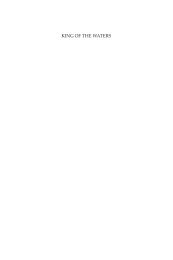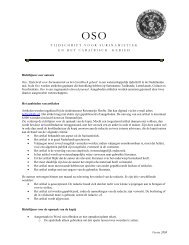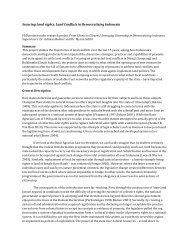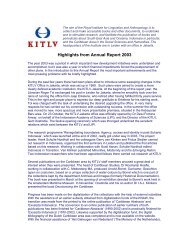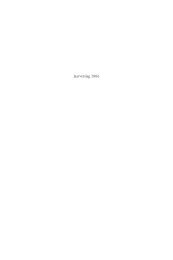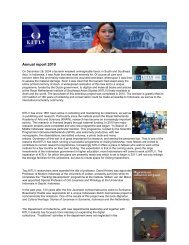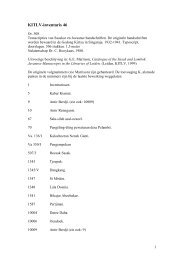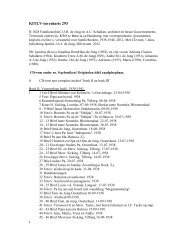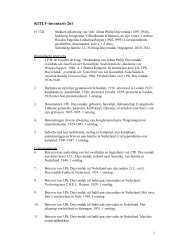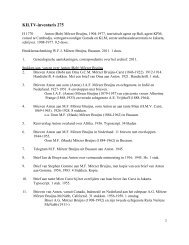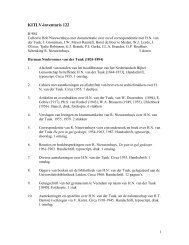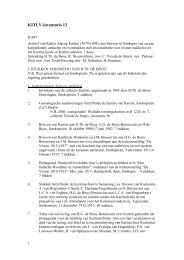Sugar And tobacco To The Baltic - kitlv
Sugar And tobacco To The Baltic - kitlv
Sugar And tobacco To The Baltic - kitlv
You also want an ePaper? Increase the reach of your titles
YUMPU automatically turns print PDFs into web optimized ePapers that Google loves.
<strong>Sugar</strong> and <strong>tobacco</strong> to the <strong>Baltic</strong><br />
<strong>The</strong> Amsterdam trade in West Indian products through the Sound in the eighteenth century<br />
Henk den Heijer (Leiden University)<br />
Views on the economic development of the Dutch Republic are subject to change. Until the<br />
1960s it was generally assumed that the economy of the Netherlands deteriorated, or at least<br />
stagnated, during the second half of the eighteenth century. In his in 1970 posthumously<br />
published magnum opus, Van Rijkdom en Regenten, J.G. van Dillen argued that the Dutch<br />
Golden Age transformed into a less resplendent Silver Age in the mid-seventeenth century.<br />
Van Dillen postulated that around 1740, after almost a century of consolidation and relative<br />
economic decline, a period of contraction which persisted until the collapse of the Republic at<br />
the end of the eighteenth century set in. 1 However, since the 1980s Van Dillen’s vision has<br />
been modified by several historians. In Dutch Primacy in World Trade, for example, Jonathan<br />
Israel has demonstrated that there was still economic growth in many sectors of the Dutch<br />
economy in the first half of the eighteenth century. Only after 1740, a century later, was there<br />
a radical change in the situation. On the other hand, Jan Luiten van Zanden and Arthur van<br />
Riel do not see any economic decline at all in the second half of the eighteenth century, but an<br />
economy in what they call stationary condition, in which there was no change until the end of<br />
the Dutch Republic. 2 Unquestionably Dutch industry was in decline, but this downturn was<br />
compensated by the growth of other economic sectors. In relative terms, the once robust<br />
international position of Dutch industry and trade was weakened by the vigorous emergence<br />
of Britain, France and some North German towns like Hamburg, Bremen and Emden. In<br />
absolute terms, however, there were no signs of deterioration at all. <strong>The</strong> province of Holland<br />
even experienced modest economic growth. 3 Certainly, a remarkable shift occurred in the<br />
kind of products which were exported in the international trade of the Republic. <strong>The</strong> export of<br />
Dutch industrial products declined, the transit trade of European commodities remained fairly<br />
stable, but the re-export of colonial products boomed in the second half of the eighteenth<br />
century. <strong>The</strong> tropical products from the plantation colonies in the Americas especially proved<br />
highly commercial in foreign markets. In the second half of the eighteenth century,<br />
1 Van Dillen, Van rijkdom en regenten, 649-657.<br />
2 Israel, Dutch Primacy in World Trade, 399-400; Van Zanden and Van Riel, Nederland 1780-1914, 31-39. See<br />
for the discussion about the Dutch economy in the eighteenth century also Van Zanden, ‘De economie van<br />
Holland’.<br />
3 Van Zanden and Van Riel, Nederland 1780-1914, 31 tabel 1.1.<br />
1
Amsterdam was still the driving force in the Dutch economy, therefore it would be feasible to<br />
expect that the re-export of Atlantic products was principally driven by Amsterdam<br />
merchants but is this expectation justified?<br />
In Early-Modern history, the Dutch trade on the <strong>Baltic</strong> was hailed as ‘the mother of all<br />
trades’ because it was the cornerstone of the Dutch economy. Every year, hundreds of Dutch<br />
ships passed through the Sound on their way to the <strong>Baltic</strong> and on their return voyage to the<br />
Republic. Grain, wood, hemp, flax, iron and tar were the chief products shipped from the<br />
<strong>Baltic</strong> Sea to Amsterdam and other Dutch port cities. Generally speaking, the volume and the<br />
value of these products increased slightly during the eighteenth century. 4 Dutch merchants<br />
who were involved in the trade through the Sound were primarily interested in products from<br />
the <strong>Baltic</strong> which they could ship to other parts of Europe. On their way to the <strong>Baltic</strong>, many<br />
ships were ballasted with sand, although they also carried commodities in demand in the<br />
region like salt, building materials, herring, wine and last but not least colonial products on<br />
board. It is assumed that the re-export of colonial products to the <strong>Baltic</strong> from the Republic<br />
grew substantially in the eighteenth century. W.S. Unger states that the volume of these<br />
commodities increased from almost 2 million pounds in the first decade of the eighteenth<br />
century to more than 5 million pounds in the 1780s. 5 However, caution is advised as his<br />
estimate is not more than an overall sketch of the combined re-export of Asian and Atlantic<br />
products to the <strong>Baltic</strong> region. Thanks to the recent digitization of the data of the Sound <strong>To</strong>ll<br />
Registers (STR), nowadays it is possible to analyse the shipping and trade through the Sound<br />
in more detail. Making grateful use of this data, the aim of this contribution is to explore the<br />
re-export of Atlantic products from Amsterdam through the Sound in the second half of the<br />
eighteenth century. Although a variety of Atlantic products were shipped to the <strong>Baltic</strong>, this<br />
paper will focus on the re-export of sugar and <strong>tobacco</strong>. Did, for example, the re-export of<br />
these two important colonial products follow the pattern sketched by Unger or not? What was<br />
the position of Dutch merchants? Were they, as in the seventeenth century and in the first<br />
decades of the eighteenth century, still the most important suppliers of these product, or were<br />
they being outstripped by the British and the French who produced much more sugar and<br />
<strong>tobacco</strong> in their plantation colonies than the Dutch did? Before I focus on this question, I shall<br />
begin with an examination of the position of the Dutch in the sugar and <strong>tobacco</strong> business<br />
before the mid-eighteenth century.<br />
4 De Buck and Lindblad, ‘De scheepvaart en handel uit de Oostzee’, 536-562.<br />
5 Unger, ‘De publicatie der Sonttabellen voltooid’, 165-167 en 194-195.<br />
2
<strong>The</strong> rise of the sugar and <strong>tobacco</strong> trade<br />
Since the mid-sixteenth century, the North Netherlands had been importing sugar, <strong>tobacco</strong><br />
and other tropical products from various regions in the Atlantic. Initially, sugar and <strong>tobacco</strong><br />
were luxury products which were shipped from Spanish and Portuguese ports to the South<br />
Netherlands in small quantities and from there travelled to the northern provinces. <strong>Sugar</strong> and<br />
<strong>tobacco</strong> arrived in Europe from the colonies as raw or semi-processed products and they were<br />
refined in Antwerp and other Flemish cities before they were transported to the North<br />
Netherlands. This was to change during the final decades of the sixteenth century when the<br />
economy of the South Netherlands was heavily disrupted by the revolt against Spain. Seizing<br />
their opportunity, merchants in port cities in Holland and Zeeland launched a direct trade with<br />
Atlantic regions from which these colonial products originated. As this trade flourished, the<br />
sugar and <strong>tobacco</strong> processing industries shifted from Flanders to the northern provinces.<br />
Within a few decades the Republic became a major importer and processor of sugar and<br />
<strong>tobacco</strong>, which were exported to various destinations in Europe. But where exactly did Dutch<br />
merchants buy these product and to which countries in Europe were they exported?<br />
Most of the sugar imported during the initial phase of the Dutch involvement in the<br />
sugar trade was produced in Brazil. <strong>The</strong>re is some evidence which suggests that Dutch ships<br />
sailed to this colony to obtain raw sugar in the last two decades of the sixteenth century. In<br />
1598, for example, although at least sixteen Dutch ships made a voyage to Brazil, the bulk of<br />
the imported sugar was still bought in Lisbon. 6 It was not until the 1630s, after the West India<br />
Company (WIC) had conquered a large part of northeast Brazil, that the Republic became a<br />
major player on the European sugar market. Between 1635 and 1645, large quantities of raw<br />
sugar were shipped from Dutch Brazil to the Republic. 7 <strong>The</strong> lion’s share of it arrived in<br />
Amsterdam where a large sugar-processing industry developed very quickly. Ten years before<br />
the loss of northeast Brazil in 1654, Dutch colonists had introduced the cultivation of sugarcane<br />
into the Caribbean. <strong>The</strong>reafter Dutch and non-Dutch plantation colonies began to<br />
produce sugar most of which was exported to the Republic. In 1661, approximately sixty<br />
sugar refineries, about half of all refineries in Europe, were operating in Amsterdam. Fifty<br />
years earlier the city had had only three refineries within its walls. 8 However, the growing<br />
production of sugar in the English and French plantation colonies, combined with increasing<br />
mercantilist measures adopted by the mother countries, caused a decline of the Dutch in sugar<br />
6 Sluiter, ‘Dutch-Spanish rivalry in the Caribbean’, 170; Ebert, ‘Dutch trade with Brazil’, 49-75.<br />
7 Wätjen , Das holländische kolonialreich in Brasilien, 322-323.<br />
8 Reesse, De suikerhandel van Amsterdam, 105-107.<br />
3
trade within Europe. At the beginning of the eighteenth century, the number of sugar<br />
refineries in Amsterdam had slumped to thirty. 9 But this was only a temporary setback,<br />
relatively speaking at least. <strong>The</strong> enormous expansion in the sugar production in the Caribbean,<br />
including the Dutch colonies in the Guyana’s, brought the price of sugar down thereby<br />
stimulating its consumption in Europe. <strong>The</strong> fly in the ointment was that the trans-Atlantic<br />
shipping was then seriously disrupted by military conflicts between Britain, France and Spain.<br />
Despite the warfare which raged almost without a break throughout the century, the Dutch<br />
Republic pursued a policy of neutrality during a large part of the eighteenth century.<br />
Benefiting from this policy Dutch merchants could actually profit from the conflicts between<br />
the major powers in the Caribbean and emerged as important players in the trans-Atlantic<br />
sugar trade once again. Around 1740, approximately 165 sugar refineries were operating in<br />
the Republic. 10<br />
Before the arrival of the first Europeans in the New World, <strong>tobacco</strong> was already<br />
cultivated and consumed by the Indians on Caribbean islands and on the American continent.<br />
In the second half of the sixteenth century Europeans were buying <strong>tobacco</strong> from the Indians,<br />
but they had also experimented with cultivating the crop on a small scale in their first<br />
settlements in the New World. <strong>The</strong> habit of smoking <strong>tobacco</strong> spread very fast and around<br />
1600 it had become customary in virtually all European countries. As sugar had done before<br />
it, <strong>tobacco</strong> emerged as an interesting commercial crop for colonist and merchants. 11 <strong>The</strong><br />
Spaniards were the first to cultivate <strong>tobacco</strong> and initiated the commercial production of this<br />
crop, and were soon followed by Portuguese colonists in Brazil. At the beginning of the<br />
seventeenth century, English settlers in Virginia began experimenting with a local <strong>tobacco</strong><br />
crop, which turned out to be of much better quality than the Spanish <strong>tobacco</strong>. From Virginia<br />
the commercial production of <strong>tobacco</strong> spread to Maryland, Barbados, Nevis, Antigua,<br />
Martinique and other Caribbean islands. 12 Although the Dutch were only marginally involved<br />
in producing <strong>tobacco</strong> in their colonies in the Caribbean, but within next to no time they did<br />
manage to dominate the <strong>tobacco</strong>-processing industry and the <strong>tobacco</strong> trade in Europe. Much<br />
of the <strong>tobacco</strong> grown in the English, French and Spanish colonies ended up in Amsterdam. At<br />
an early stage, around 1610, <strong>tobacco</strong> seeds were imported into the Republic and planted in the<br />
province of Zeeland. From there the cultivation of <strong>tobacco</strong> spread to the provinces of Utrecht<br />
and Gelderland. In the second half of the seventeenth century, large quantities of cheap<br />
9 Le Long, Den koophandel van Amsterdam, 129.<br />
10 De Vries and Van der Woude, Nederland 1500-1815, 386.<br />
11 Roessingh, Inlandse tabak, 60-61.<br />
12 Davies, <strong>The</strong> North Atlantic World, 145.<br />
4
<strong>tobacco</strong> which was blended with the more expensive quality <strong>tobacco</strong> from the English<br />
colonies in North America, were grown in these provinces. 13 Hence, a relatively cheap and<br />
good quality <strong>tobacco</strong> was being produced which could compete with all other sorts of <strong>tobacco</strong><br />
on the European markets. Until the beginning of the eighteenth century Amsterdam was the<br />
most important centre in Europe for the spinning and blending of various sorts of <strong>tobacco</strong>.<br />
Some of the processed <strong>tobacco</strong> was consumed in the Republic, but the bulk of it was<br />
exported. Although there was a growing market for <strong>tobacco</strong> throughout the whole of Europe,<br />
the major markets were the northern countries. It is estimated that around 1700 approximately<br />
15 million pounds of ‘Dutch’ <strong>tobacco</strong> was shipped to the <strong>Baltic</strong> Sea. 14<br />
<strong>The</strong> Amsterdam sugar and <strong>tobacco</strong> trade in the eighteenth century<br />
During the seventeenth century Amsterdam had built up a leading position in the sugar and<br />
<strong>tobacco</strong> trade in the Republic and in Europe. In the last quarter of the century, however, that<br />
position was put under pressure because of a growing competition of England and France. At<br />
the beginning of the eighteenth century, the number of sugar refineries in Amsterdam had<br />
slumped to thirty, in which fewer than six hundred workers were employed. 15 <strong>The</strong> Amsterdam<br />
<strong>tobacco</strong> industry, on the other hand, was still flourishing. In 1700 approximately three<br />
thousand workers were employed in the <strong>tobacco</strong> spinning and blending industry, about three<br />
per cent of the Amsterdam labour force. 16 It was too good to last, a decade later the <strong>tobacco</strong><br />
industry had also begun to stagnate.<br />
It seems as if the previously successful sugar and <strong>tobacco</strong> trade of Amsterdam ended<br />
in a period of contraction in the first decade of the eighteenth century, but this was not the<br />
case. <strong>The</strong> Republic still retained its strong position in distribution and was soon able to take<br />
advantage of the growing demands for Atlantic products in Europe. Owing to the large drop<br />
in sugar and <strong>tobacco</strong> prices, these products had now come within the reach of large consumer<br />
groups. Furthermore, throughout a good part of the century the Republic was able to pluck the<br />
fruits of being able to pursue a policy of neutrality from the end of the War of the Spanish<br />
Succession (1702-1713) until the Fourth Anglo-Dutch War (1780-1784. During military<br />
conflicts between Britain, France and Spain, some of which were fought in the Caribbean,<br />
Curacao and St Eustatius came in very handy as free ports from which large quantities of<br />
13 Roessingh, Inlandse tabak, 186-207, 391-400.<br />
14 Ibidem, 416-418.<br />
15 Le Long, Den koophandel, 129.<br />
16 De Vries and Van der Woude, Nederland 1500-1815, 383.<br />
5
colonial products could be shipped to Europe. A major part of these products ended up in<br />
Amsterdam where they were processed and re-exported to other European destinations.<br />
During the first half of the eighteenth century not only did the sugar trade pick up,<br />
the sugar-processing industry was also re-invigorated, a remarkable achievement because by<br />
then Dutch sugar-processing technology had found its way to other European countries. 17 One<br />
might have expected that a country like France, with the most productive sugar colonies in the<br />
Caribbean, would have taken the initiative to begin refine sugar on a large scale and ruin the<br />
Dutch sugar industry, but this did not happen. In fact the reverse was true. Money was the key<br />
to this. <strong>Sugar</strong> refineries were large enterprises which required substantial investment. Capital<br />
was available in the Republic, but not in France. For a long time the French refining capacity<br />
could not keep up with the explosive growth of the sugar production in the colonies, so large<br />
quantities of semi-refined and raw sugar were re-exported to other countries. <strong>The</strong> first stages<br />
of refining semi-refined sugar, the ‘sucre terré’, were carried out in the French colonies, but<br />
the purification had to be left to European refineries. Until 1790 the Republic was the largest<br />
purchaser of French export sugar. 18 Besides refineries, there were companies within the<br />
Republic which were specialized in producing more luxury sorts of sugar like candy. <strong>The</strong>se<br />
companies produced all kinds of white, yellow and brown sugar as well as loaf sugar. 19<br />
Golden syrup, a residual product of the sugar-refining process, was used as a cheap substitute<br />
Table 1: <strong>Sugar</strong> imports of Amsterdam, 1742-1796 (in pounds 20 )<br />
Year Surinam Ess-Dem-Berb St. Eustatius France Other <strong>To</strong>tal<br />
1742 24,555,000 1,600,000 1,840,000 5,51,000 942,000 34,688,000<br />
1753 12,224,000 1,600,000 2,500,000 15,005,000 6,000 31,335,000<br />
1771 16,251,000 2,405,000 14,179,000 16,972,000 6,608,000 56,415,000<br />
1775 16,204,000 2,725,000 4,802,000 13,301,000 8,469,000 45,501,000<br />
1780 12,560,000 7,992,000 30,434,000 257,000 6,281,000 57,524,000<br />
1785 12,941,000 7,992,000 3,944,000 12,874,000 9,664,000 47,415,000<br />
1790 16,884,000 19,174,000 7,524,000 18,798,000 1,911,000 64,291,000<br />
1796 235,000 6,234,000 6,469,000<br />
<strong>To</strong>tal 111.619.000 43,488,000 65,223,000 83,193,000 40,115,000 343,638,000<br />
Sources: Nassy et al, Essai historique, seconde partie, 88-95; Van der Oest, ‘<strong>The</strong> forgotten colonies’, 350 table<br />
12.6 (A); Oldewelt, ‘De scheepvaartstatitiek’, 130-149 bijlage II; Klooster, Illicit Riches, 226 appendix 5;<br />
Reesse, De suikerhandel, cxx bijlage G; Van Nierop, ‘Uit de bakermat’, Amstelodamum 15, 143-144 bijlage A;<br />
database Welling.<br />
17 Davids, <strong>The</strong> Rise and Decline, volume 2, 343-344.<br />
18 Van de Voort, De Westindische plantages van 1720 tot 1795, 144-146.<br />
19 Reesse, De suikerhandel van Amsterdam, 153-157. See for the refining process Reisig, De suikerraffinadeur.<br />
20 <strong>The</strong> weight is displayed in Amsterdam pounds. An Amsterdam pound weighed 0.49 kilograms.<br />
6
for sugar to be sold to the less fortunate. In 1740, approximately 165 sugar refineries were<br />
operating in the Republic, most of them in Amsterdam. 21 This number remained relatively<br />
stable until the end of the eighteenth century.<br />
<strong>The</strong> bulk of the sugar which was imported into the Republic from the Dutch colonies<br />
and foreign European port cities ended up in Amsterdam. From 1742 until the end of the<br />
eighteenth century we have fairly reliable import figures for a number of sample years at our<br />
disposal. <strong>The</strong>se figures show that between 1742 and 1790 the import increased from nearly<br />
34.7 million pounds of sugar to nearly 64.3 million pounds, but the growth in the sugar import<br />
was subject to enormous fluctuations (Table 1).<br />
Unsurprisingly most of the Amsterdam sugar was shipped from Surinam as the city<br />
had a one-third share participation in the Society of Surinam which was responsible for the<br />
government of the colony and many Amsterdam business firms had invested capital in<br />
Surinamese plantations. Only a small quantity of the sugar from the colony was shipped to<br />
port cities in Zeeland, and most of this was re-shipped to Amsterdam which had a much larger<br />
sugar-refining capacity than, for example, Middelburg. <strong>The</strong> reason Amsterdam merchants<br />
imported only a small quantity of sugar from the plantation colonies of Berbice, Demerara<br />
and Essequibo (now Guyana) That was because Zeeland had held a trade monopoly on the<br />
latter two colonies since the seventeenth century. Only after Stadtholder William V abolished<br />
the Zeeland monopoly in 1771, did the contribution of these small colonies to the total sugar<br />
import of Amsterdam begin to increase. <strong>The</strong> sugar imports via St Eustatius could be fairly<br />
volatile. <strong>The</strong> island played an important role as a transit port during the eighteenth-century<br />
European wars which were partly fought out in the Caribbean. In times of conflict, friend and<br />
foe alike used St Eustatius as a neutral port from where sugar and other colonial products<br />
could be safely shipped to Europe. During the Seven Years War (1756-1763), for instance, St<br />
Eustatius exported large quantities of sugar to Amsterdam, in the peak year 1761 almost 18<br />
million pounds. When the war was over, the export of sugar dropped back to the pre-war<br />
quantity of 5 to 6 million pounds per year. In 1780, during the American War of<br />
Independence (1775-1783), a record of over 30 million pounds was reached, the greatest<br />
amount of sugar ever imported into Amsterdam from a colony in one year. 22 Almost a third of<br />
Amsterdam sugar was supplied through other European ports. Until the last decade of the<br />
eighteenth century, these were almost exclusively Bordeaux, Nantes and some other French<br />
port cities. After Britain had joined the First Coalition against France in 1793, French<br />
21 De Vries en Van der Woude, Nederland 1500-1815, 386.<br />
22 Klooster, Illicit Riches, 226 Appendix 5.<br />
7
overseas trade was severely hampered, and the sugar export to the Republic stagnated. A<br />
partial solution was soon found and part of the raw sugar which was needed to keep the main<br />
refineries working was imported from Britain and the North German port cities of Hamburg<br />
and Bremen, but that amount of sugar was significantly smaller than imported from France in<br />
previous years. 23<br />
Despite the political instability, the volume of the Dutch sugar export in the second<br />
half of the eighteenth century remained high, notwithstanding the increasing competition from<br />
other players on the European sugar market. This stability can in part at least be attributed to<br />
the government which issued various measures to protect the sugar industry in the<br />
Netherlands. Consequently, in 1756 the production of the sugar refinery on St Eustatius was<br />
curbed and in 1771 the excise duty on the transit of raw sugar to the German hinterland was<br />
doubled. 24 On several occasions tax reductions were also allowed for sugar refined in the<br />
Netherlands, in an attempt to make it more competitive on the European market. 25 Only in the<br />
last five years of the eighteenth century did the export of refined sugar decline sharply.<br />
<strong>To</strong>bacco was the second economically important Atlantic product in the economy of<br />
the Dutch Republic. As has been said, blending cheap domestic <strong>tobacco</strong> with small quantities<br />
of expensive but superior North American <strong>tobacco</strong> produced a very good value-for-money<br />
product, with which the Republic conquered the European <strong>tobacco</strong> market in the seventeenth<br />
century. Amsterdam was the greatest beneficiary of these developments and became the major<br />
European <strong>tobacco</strong> processing and trading centre. Around 1700, there were about three<br />
thousand people working in the Amsterdam <strong>tobacco</strong> industry. 26 In the course of the eighteenth<br />
century, however, the Republic had to cede its advantage to other <strong>tobacco</strong>-producing and<br />
exporting countries. After a price reduction in the superior American <strong>tobacco</strong>, the Dutch blend<br />
of domestic and foreign <strong>tobacco</strong> lost its attraction for European consumers. Furthermore, just<br />
as the technology for refining sugar had been, that for processing <strong>tobacco</strong> was exported from<br />
the Republic to other European countries. Benefiting from this transfer of knowledge,<br />
Scandinavian countries like Sweden and Denmark were able to set up their own <strong>tobacco</strong><br />
industry, making them less dependent of Dutch imports. 27 After the mid-eighteenth century<br />
these countries usually turned to importing unprocessed <strong>tobacco</strong> leaves instead of different<br />
kinds of finished <strong>tobacco</strong>. <strong>The</strong> final hindrance to the Dutch export of processed <strong>tobacco</strong> was<br />
23 Van Nierop, ‘Uit de bakermat der Amsterdamsche handelsstatistiek’ (1917) bijlage c.<br />
24 Knappert, Geschiedenis van de Nederlandsche Bovenwindsche eilanden, 256-257; Visser, Verkeersindustrieën<br />
te Rotterdam, 32.<br />
25 Visser, Verkeersindustrieën te Rotterdam, 32-33; De Vries and Van der Woude, Nederland 1500-1815, 387.<br />
26 De Vries and Van der Woude, Nederland 1500-1815, 383.<br />
27 Davids, <strong>The</strong> rise and decline, volume 2, 344-345.<br />
8
the growing import restrictions which various European governments proclaimed. All these<br />
factors combined to cause a shrinkage in the production of domestic <strong>tobacco</strong>, compensated by<br />
an increasing import of American <strong>tobacco</strong> in the eighteenth century. In 1710, between 15 and<br />
18 million pounds of <strong>tobacco</strong> was being grown in the Netherlands, topped up by 7 million<br />
pounds of American <strong>tobacco</strong> imported via British ports. Forty years later, the domestic<br />
production had fallen to just 11 or 12 million pounds a year and imports had increased to 17<br />
million pounds a year. 28 Large quantities of the American <strong>tobacco</strong> which arrived in<br />
Amsterdam was re-exported to other European port cities unprocessed. Contrary to what<br />
might have been expected, Britain was not the only or always the most important supplier of<br />
Atlantic <strong>tobacco</strong>. In certain years the supply of what was known as Varinas <strong>tobacco</strong>,<br />
cultivated in Venezuela, was just as important. Although a small quantity of this <strong>tobacco</strong> was<br />
shipped via Curacao, the majority of it was imported from Spain. 29 However, the share of the<br />
Varinas <strong>tobacco</strong> in the total import of Amsterdam was subject to sharp fluctuations.<br />
Especially during the American War of Independence, when the supply of North American<br />
<strong>tobacco</strong> through British ports virtually ground to a standstill, the import of Varinas <strong>tobacco</strong><br />
rose sharply. In 1742 for instance only 9.4 percent of all Atlantic <strong>tobacco</strong> imported by<br />
Amsterdam came from Venezuela; by 1776 the share of Varinas <strong>tobacco</strong> had increased to<br />
64.5 percent. 30 In times of war, the amount imported via St Eustatius grew very quickly. 31<br />
As was the case with sugar, the Amsterdam import and export trade in <strong>tobacco</strong> grew<br />
almost constantly during the eighteenth century. 32 It is true that the share of Amsterdam in the<br />
European sugar and <strong>tobacco</strong> trade did decline in the second half of the century, but in absolute<br />
terms it increased significantly. De Vries and Van der Woude have estimated that<br />
approximately one-third of the imported sugar was consumed in the Netherlands, 33 but the<br />
import and export data available show that twice as much Amsterdam sugar was sold in the<br />
Republic than has been assumed. In 1753, approximately 34.2 percent of the 31.3 million<br />
pounds of imported sugar was exported after processing. In 1790, this import amounted 64.3<br />
million pounds of which 34.8 percent was exported as a refined product, in terms of<br />
percentage only a fraction more than the situation forty-seven years earlier. 34 A comparison<br />
28 Roessingh, Inlandse tabak, 340 tabel 6.13.<br />
29 Klooster, Illicit Riches, 230-231 appendix 7.<br />
30 See database George Welling: http://odur.let.rug.nl/welling/appendix.html<br />
31 Klooster, Illicit Riches, 226-227 appendix 5.<br />
32 Due to the lack of sufficient serial data about the volume of imported <strong>tobacco</strong> it is yet not possible to create a<br />
general overview like for sugar in table 1.<br />
33 De Vries en Van der Woude, Nederland 1500-1815, 387.<br />
34 See for the import of Amsterdam table 1 of this paper and for the export Van Nierop, ‘Uit de bakermat’,<br />
Amstelodamum 13, 143 bijlage A.<br />
9
with the Amsterdam <strong>tobacco</strong> import and export industry shows an entirely different trend,<br />
although we only know the value of the <strong>tobacco</strong> trade, not its volume. In 1753 <strong>tobacco</strong> worth<br />
202,208 guilders was imported and to the value of 1,037,266 guilders was exported.<br />
Expressed in terms of value, 513 percent more <strong>tobacco</strong> was exported than imported. In 1790<br />
the import value was 281,795 guilders against an export value of 1,842,660 guilders, a<br />
difference of no less than 654 percent. 35 On the face of it, in the second half of the eighteenth<br />
century the <strong>tobacco</strong> trade of Amsterdam was much more successful that the sugar trade, but<br />
this conclusion is too facile. All the sugar refined in Amsterdam was imported, but that was<br />
not the case with <strong>tobacco</strong>. Despite the decline in the domestic production, there was still<br />
plenty of Dutch-grown <strong>tobacco</strong> which was blended with imported Atlantic <strong>tobacco</strong>. During<br />
the last quarter of the eighteenth century, Dutch <strong>tobacco</strong> cultivation even recovered. 36<br />
However, it is very doubtful if the big difference between the import and the export value can<br />
be fully attributed to the Dutch-grown <strong>tobacco</strong>. It is more likely that, until the end of the<br />
eighteenth century, a large <strong>tobacco</strong> industry existed in Amsterdam, which contributed<br />
substantially to the added value of the <strong>tobacco</strong> exported. How much that was will have to be<br />
settled by further research.<br />
So far most of the focus has been directed towards the Amsterdam import and export<br />
industries in sugar and <strong>tobacco</strong>, but other towns in the Republic were also involved in the<br />
processing and trading of these products. Cities like Middelburg, Gouda and ‘s-<br />
Hertogenbosch had one or two sugar refineries within their walls, producing commodities for<br />
local or regional markets. Rotterdam presented a different picture as the bulk of its sugar and<br />
<strong>tobacco</strong> was processed for export. In the second half of the eighteenth century, significant<br />
changes between Amsterdam and Rotterdam occurred. In 1752 Rotterdam had thirty sugar<br />
refineries, but that number shrank to nineteen in 1767 to twelve in 1771, after which the<br />
number remained stable until the end of the century. Nevertheless, C. Visser argues that the<br />
decrease in the number of sugar refineries did not result in a contraction of the production,<br />
because the number of large refineries did not change. <strong>The</strong> export of refined sugar from<br />
Rotterdam actually rose from nearly 7 million pounds in 1753 to over 9 million pounds in<br />
1790. 37 Amsterdam, on the other hand, exported more than 10.7 million pounds of sugar in<br />
1753 against over 20.7 million pounds in 1790. 38 <strong>The</strong>se figures show that the competiveness<br />
of Rotterdam with respect to Amsterdam deteriorated significantly in half a century. <strong>The</strong><br />
35 See Van Nierop, ‘Uit de bakermat’, Amstelodamum 13 (export) and 14. (export).<br />
36 Roessingh, Inlandse tabak, 350-370.<br />
37 Visser, Verkeersindustrieën, 54-55.<br />
38 Van Nierop, ‘Uit de bakermat’ Amstelodamum 13, 143 bijlage A.<br />
10
Amsterdam sugar export had almost doubled, while that of Rotterdam increased by only 30<br />
percent. <strong>The</strong>re were some other notable differences between the two cities. In Amsterdam raw<br />
sugar was largely imported from the Dutch colonies in the West, whereas in Rotterdam almost<br />
all of it came from French port cities. It is also noteworthy that Amsterdam marketed twothirds<br />
of its production domestically but Rotterdam re-exported practically all the sugar<br />
refined in the city. Unfortunately there are no series available recording the volumes or values<br />
of the <strong>tobacco</strong> import and export of Amsterdam and Rotterdam, but a good indicator is the<br />
excise duty on <strong>tobacco</strong> which was levied in both cities between 1764 and 1804. This<br />
demonstrates that, until 1775, Rotterdam was more important for the import of <strong>tobacco</strong> than<br />
Amsterdam. During the American War of Independence the role of Rotterdam was<br />
temporarily taken over by Amsterdam, but when the War was over the roles were reversed<br />
again, until 1795 at least. 39 On the basis of the import tax levied, it seems that Amsterdam was<br />
overtaken by Rotterdam in the processing and trade of <strong>tobacco</strong> in the course of the eighteenth<br />
century. In a nutshell, both cities experienced a growth in absolute terms, but this growth<br />
occurred much faster in Rotterdam than in Amsterdam. In the second half of the eighteenth<br />
century, the <strong>tobacco</strong> industry in Rotterdam employed approximately three thousand five<br />
hundred people. 40<br />
Table 2: <strong>Sugar</strong> export of Amsterdam in 1753 and 1790 (volume)<br />
Destination 1753 1790<br />
pound % pound %<br />
Portugal 3,670 0.3% 7,847 0.04%<br />
Spain 129,811 1.21% 37,687 0.17%<br />
France 6,435 0.06% 63,695 0.28%<br />
Great Britain 38,755 0.36%<br />
German hinterland 6,590,266 61.33% 17,996,118 80.50%<br />
Mediterranean 30,160 0.28% 209,590 0.94%<br />
Hamburg, Bremen etc. 1,149,618 10.70% 1,608,810 7.20%<br />
Norway / <strong>Baltic</strong> Sea 2,796,577 26.03% 853,913 3.82%<br />
Northern Russia 1,257,973 5.63%<br />
South Netherlands 320,402 1.43%<br />
10,745,292 100.00% 22,356,035 100.00%<br />
Source: Van Nierop, ‘Uit de bakermat’, Amstelodamum 13, bijlage A.<br />
39 Roessingh, Inlandse tabak, 478-479.<br />
40 Visser, Verkeersindustrieën, 155.<br />
11
Table 3: <strong>To</strong>bacco export of Amsterdam in 1753 and 1790 (value)<br />
Destination 1753 1790<br />
guilders % guilders %<br />
Portugal 510 0.05% 780 0.04%<br />
Spain 9,650 0.93% 16,788 0.91%<br />
France 87,841 8.47% 53,000 2.88%<br />
Great Britain 2,300 0.22% 1,915 0.10%<br />
German hinterland 155,491 14.99% 604,362 32.80%<br />
Mediterranean 103,695 10.00% 338,382 18.36%<br />
Hamburg, Bremen etc. 280,263 27.02% 338,079 18.35%<br />
Norway / <strong>Baltic</strong> Sea 396,401 38.22% 354,164 19.22%<br />
Northern Russia 37,555 2.04%<br />
South Netherlands 97,635 5.30%<br />
Unknown 1,115 0.11%<br />
1,037,266 100.00% 1,842,660 100.00%<br />
Source: Van Nierop, ‘Uit de bakermat’, Amstelodamum 13, bijlage A.<br />
W.S. Unger has, as is shown in the introduction of this paper, been able to substantiate the<br />
claim that Dutch export of colonial products to the <strong>Baltic</strong> Sea rose continuously during the<br />
eighteenth century. His evidence is based on the source publication of the Sound <strong>To</strong>ll<br />
Registers by Bang and Korst. <strong>The</strong> question is whether this was equally true of sugar and<br />
<strong>tobacco</strong>. Thanks to the surviving export figures of Amsterdam from the years 1753 and 1790<br />
(Tables 2 and 3), it is possible to investigate the European regions to which the city was<br />
exporting its sugar and <strong>tobacco</strong>. In the mid-eighteenth century, Amsterdam exported more<br />
than 60 percent of its refined sugar to the German hinterland either via the Rhine or along<br />
country roads. Norway and the <strong>Baltic</strong> Sea were in second place with over 26 percent of the<br />
export. By 1790 the importance of the sugar export to Norway and the <strong>Baltic</strong> had fallen<br />
sharply in favour of that to the German hinterland. Table 3 shows that the <strong>tobacco</strong> export of<br />
Amsterdam experienced a similar but less dramatic shift. Also remarkable is the increase in<br />
the <strong>tobacco</strong> export to the Mediterranean. <strong>The</strong> shift in the export from the <strong>Baltic</strong> to the German<br />
hinterland was part of an overall pattern in the international trade of the Republic, one which<br />
was already emerging before the mid-eighteenth century. 41 Although the volume of the trade<br />
of the Republic had been increasing almost without a break, the flow of commodities exported<br />
showed a steady shift away from the <strong>Baltic</strong> to the Rhineland. This raises the question of what<br />
the trends in the Amsterdam export of sugar and <strong>tobacco</strong> to the <strong>Baltic</strong> were in the second half<br />
of the eighteenth century.<br />
41 De Vries, ‘De problematiek’, 28.<br />
12
Amsterdam sugar and <strong>tobacco</strong> trade through the Sound 42<br />
Thanks to the painstaking work of the Danish historians Nina Ellinger Bang and Knud Korst,<br />
who have published a seven-volume series of aggregated Sound <strong>To</strong>ll Registers data,<br />
researchers now have at their disposal an impressive quantitative overview of the trade to and<br />
from the <strong>Baltic</strong> through the Sound in the Early-Modern period. 43 Earlier in this paper it was<br />
revealed that, using this dataset, Unger has shown that the volume of the Dutch export of<br />
colonial products through the Sound increased considerably during the eighteenth century, but<br />
fell significantly in terms of percentages. In the first decade, approximately 2 million pounds<br />
of colonial products were annually shipped from Amsterdam to the <strong>Baltic</strong>, accounting for<br />
about 68 percent of the total amount of Atlantic and Asiatic goods passing through the Sound.<br />
Between 1771 and 1780, the volume of this category of products had increased to an average<br />
of 5.3 million pounds per year; 265 percent more than at the beginning of the century, but<br />
only 20 percent of the total export of these products in that period. 44 <strong>The</strong> present Sound <strong>To</strong>ll<br />
Registers database makes it possible to study the export of colonial products in greater detail<br />
than was possible with Bang and Korst’s former dataset. Various products from Africa and<br />
the plantation colonies in the Americas were shipped through the Sound via Dutch port cities.<br />
Besides large quantities of plantation products like sugar, <strong>tobacco</strong>, cotton, indigo, cocoa and<br />
coffee, the ships carried small amounts of ivory, gum and various kinds of dyestuffs. <strong>The</strong><br />
export of the first two products through the Sound from Amsterdam in the second half of the<br />
eighteenth century is the central theme of this section. It is possible to deduce from Tables 2<br />
and 3, in which the export of sugar and <strong>tobacco</strong> from Amsterdam in 1753 and 1790 are<br />
compared, that the volume of the export hardly changed over the years. <strong>The</strong>se tables are based<br />
on data of export taxes levied by the Admiralty of Amsterdam. <strong>The</strong> data in the Sound <strong>To</strong>ll<br />
Registers differs slightly from those of the Admiralty, a discrepancy which can be explained<br />
by smuggling activities. It is very unlikely that skippers always gave the authorities the<br />
correct amount of loaded goods. Using the data in the Sound <strong>To</strong>ll Registers, I shall explore<br />
how the export of sugar and <strong>tobacco</strong> from Amsterdam through the Sound could surpass that of<br />
other European players. Until what time was Amsterdam capable of maintaining its leading<br />
position in the sugar and <strong>tobacco</strong> trade on the <strong>Baltic</strong>? <strong>The</strong> shifts which occurred in the trade<br />
within the <strong>Baltic</strong> region will be examined in the search for an answer.<br />
42 This paragraph is based on the Sound <strong>To</strong>ll Registers online (http://www.soundtoll.nl/index.php/nl/), unless<br />
otherwise stated.<br />
43 Bang and Korst, Tabeller over skibsfart og vaeretransport gennem Oeresund, 7 volumes.<br />
44 Unger, ‘De publicatie der Sonttabellen voltooid’, 165-167 and 194-195; Lesger, ‘Stagnatie en stabiliteit’, 232-<br />
237.<br />
13
As said, Amsterdam was not the sole player, Rotterdam also had substantial interests<br />
in the Dutch sugar and <strong>tobacco</strong> trade but the latter port did not play a significant role in the<br />
shipping of those products through the Sound. In the second half of the eighteenth century<br />
only twenty-four ships with sugar loaded in Rotterdam passed eastwards through the Sound.<br />
As a whole these ships carried 90,000 pounds of sugar, scarcely 0.2 percent of the amount of<br />
the sugar exported from Amsterdam to the <strong>Baltic</strong> Sea. Rotterdam merchants were not<br />
insignificant re-exporters of sugar but, as said, they shipped almost all their colonial products<br />
either to the German hinterland via the Rhine and to the South Netherlands. 45 Although<br />
<strong>tobacco</strong> was much more important to the economy of Rotterdam than sugar, only forty-six<br />
ships loaded with <strong>tobacco</strong> sailed from Rotterdam to the <strong>Baltic</strong> Sea in the second half of the<br />
eighteenth century. In the same period 4,821 vessels carrying <strong>tobacco</strong> from Amsterdam sailed<br />
eastwards through the Sound,, hence the decision to focus on Amsterdam as a principal port<br />
for the shipping of sugar and <strong>tobacco</strong> through the Sound is obvious. Yet it is not so easy to<br />
chart the volume of exports accurately. This is because the Sound <strong>To</strong>ll Registers contain more<br />
than twelve hundred spelling variations of the word sugar and of combinations of sugar with<br />
other products. <strong>To</strong>bacco has over eight hundred spellings variations in the database. That<br />
makes it practically impossible to trace all the sugar and <strong>tobacco</strong> shipped from Amsterdam to<br />
the <strong>Baltic</strong> Sea. Hence, combinations of sugar or <strong>tobacco</strong> with more than two other products<br />
have not been included in the analysis of the database. 46 What the consequence will be for the<br />
estimated export of sugar and <strong>tobacco</strong> through the Sound can be only roughly determined,<br />
but based on random samples I suspect that over 90 percent of the quantity of these products<br />
has been tracked. In general, combinations of more than three products, which are only<br />
mentioned once ore twice in the database, contain small quantities of sugar or <strong>tobacco</strong>. <strong>The</strong><br />
combination sugar, anise, orleaan (a dye) and an unspecified number of other products, for<br />
instance, is only mentioned once. Johan David Schwabe from Stralsund was the only skipper<br />
who passed the Sound carrying this combination of goods and a number of separately<br />
specified products. Schwabe had left Amsterdam on a voyage to Stockholm shortly before he<br />
paid toll at Elsinore on 27 April 1750. 47<br />
45 Visser, Verkeersindustrieën te Rotterdam, 45. According to the author, at the end of the eighteenth century<br />
approximately 6 million pounds of sugar was shipped to the German hinterland and 2 million pounds to the<br />
South Netherlands.<br />
46 If combinations of sugar or <strong>tobacco</strong> with other products are listed in the Sound <strong>To</strong>ll Registers, the amount is<br />
divided by the number of products. It is in fact impossible to figure out what the amount of sugar or <strong>tobacco</strong> in<br />
such combinations was. Syrup, a waste product of sugar refining, is not included in the tables in this section.<br />
47 www.soundtoll.nl. ID number 557188.<br />
14
Volume of the export<br />
Now let us examine the export of sugar and <strong>tobacco</strong> from Amsterdam through the Sound in<br />
the second half of the eighteenth century in nine sample years.<br />
Table 4: <strong>Sugar</strong> and <strong>tobacco</strong> export of Amsterdam,1750-1790 (in pounds)<br />
Year <strong>Sugar</strong> <strong>To</strong>bacco<br />
1750 1,106,056 1,070,882<br />
1755 848,529 969,973<br />
1760 978,179 971,917<br />
1766* 945,761 1,655,319<br />
1770 1,020,778 1,153,947<br />
1775 676,004 913,011<br />
1780 949,334 757,803<br />
1785 748,832 1,344,231<br />
1790 914,931 1,150,481<br />
Average 909,823 1,109,729<br />
* <strong>The</strong> years in the table have an interval of five year. Only 1765 is missing in the<br />
Database, so the data from 1766 are included instead of 1765.<br />
Source: STR.<br />
Comparing Tables 2 and 3, showing the export of sugar and <strong>tobacco</strong> from Amsterdam in 1753<br />
and 1790 leads to the conclusion that the volume of the export hardly changed over the years.<br />
<strong>The</strong>se tables are based on data about the export tax levied by the Admiralty of Amsterdam. In<br />
1750 over 1.1 million pounds of Amsterdam refined sugar was shipped through the Sound,<br />
Forty years later, the amount of sugar was barely one hundred thousand pounds less. If one<br />
thing is clear from the data in Table 4, it is that the sugar and <strong>tobacco</strong> export to the <strong>Baltic</strong><br />
remained steady in the second half of the eighteenth century. <strong>The</strong> information in the Sound<br />
<strong>To</strong>ll Registers database confirms the limited data of the Admiralty of Amsterdam for the years<br />
1753 and 1790 in Tables 2 and 3. With a few exceptions, the volume of the export did not<br />
vary more than 10 percent in the sample years selected. <strong>The</strong>se figures are remarkably stable<br />
since the Amsterdam sugar export had increased very vigorously between 1750 and 1790,<br />
although the export through the Sound showed no growth at all. In the countries and cities<br />
around the <strong>Baltic</strong> Sea, the consumption of sugar and <strong>tobacco</strong> also increased, but the<br />
Amsterdam processors and merchants of this products did not benefit from this growth. As<br />
Unger noted, the fast-growing export in colonial products of the Republic through the Sound<br />
did not concern the Atlantic products sugar and <strong>tobacco</strong>. Not one single but a number of<br />
various factors offer the only explanation. One definitely was the transfer of knowledge of<br />
processing sugar and <strong>tobacco</strong> from the Republic to Sweden and Denmark, making these<br />
countries were no longer dependent on the import of processed sugar and <strong>tobacco</strong> from<br />
15
Amsterdam. 48 Another was that the Danes began to import an increasing amount of colonial<br />
products from their colonies in the Caribbean. Likewise Sweden received sugar and <strong>tobacco</strong><br />
through its colony Saint Barthélemy, which had been operating as a free port in the Caribbean<br />
since 1785. <strong>The</strong> import of colonial products directly from the West Indies on Danish and<br />
Swedish ships was exempt the Sound <strong>To</strong>ll, so it is impossible to trace these ships in the Sound<br />
<strong>To</strong>ll Registers. 49 A third and last important factor was the growing competition with other<br />
European nations in the sugar and <strong>tobacco</strong> trade, which brings us to the question of how the<br />
Amsterdam sugar and <strong>tobacco</strong> trade through the Sound developed in comparison with other<br />
European players.<br />
Growing competition<br />
Of course, not all ships which took on colonial products in Amsterdam were Dutch and the<br />
quantities which were exported by Dutch skippers could fluctuate from year to year.<br />
Nevertheless, leaving these provisos aside, at least three-quarters of all Amsterdam sugar<br />
which passed the Sound was loaded on Dutch vessels. Most of these Dutch ships were<br />
registered in Amsterdam or in port cities in the provinces of Friesland and Groningen.<br />
However, the Dutch share in the Amsterdam <strong>tobacco</strong> trade was smaller. More than half of the<br />
Amsterdam <strong>tobacco</strong> shipped through the Sound was exported by non-Dutch ships. Let us now<br />
take a look at the competition in the sugar and <strong>tobacco</strong> trades Amsterdam had to contend with<br />
from other countries. In the case of a large number of ships of various nationalities, the<br />
current set-up of the Sound <strong>To</strong>ll Registers database makes it difficult to calculate the<br />
quantities of products which they carried through the Sound. Consequently, I have chosen to<br />
Table 5: Number of ships passing the Sound with sugar and <strong>tobacco</strong>, 1750-1790<br />
<strong>Sugar</strong><br />
<strong>To</strong>bacco<br />
Year Amsterdam <strong>To</strong>tal % Amsterdam Amsterdam <strong>To</strong>tal % Amsterdam<br />
1750 137 246 56% 152 243 63%<br />
1755 86 205 42% 115 235 49%<br />
1760 86 202 43% 116 202 57%<br />
1766 95 267 36% 112 195 57%<br />
1770 62 200 31% 82 144 57%<br />
1775 107 238 45% 84 116 72%<br />
1780 86 299 29% 91 190 48%<br />
1785 73 310 24% 105 204 51%<br />
1790 79 324 24% 89 178 50%<br />
Source: STR.<br />
48 Davids, <strong>The</strong> rise and decline, volume 2, 344-345.<br />
49 Rönnbäck, ‘Who Stood to Gain from Colonialism?’, 72.<br />
16
calculate the number of ships from Amsterdam compared with ships from other European<br />
(non-Dutch) port cities which passed eastwards through the Sound with a cargo of sugar<br />
and/or <strong>tobacco</strong>.<br />
Obviously the number of ships from Amsterdam which passed the Sound eastwards<br />
with sugar and <strong>tobacco</strong>, as shown in Table 5, gradually decreased in the second half of the<br />
eighteenth century, while the total number of European ships carrying sugar increased in the<br />
period researched, but the number of ships carrying sugar was dwindling much faster than that<br />
of the ships with <strong>tobacco</strong>.<br />
In the mid-eighteenth century, 56 percent of all ships with sugar on board were loaded<br />
in Amsterdam. In 1790 this percentage was dropped to 24 percent, but the amount of sugar<br />
exported from the city remained approximately the same as was previously determined (Table<br />
4). <strong>The</strong> biggest competitors of Amsterdam were French merchants who were sending more<br />
and more ships with sugar to the <strong>Baltic</strong>. In 1750, forty-one French vessels carried sugar<br />
through the Sound, and in 1790 the number of French ships had increased to ninety-one. In<br />
that year for the first time the number of vessels which were fitted out in French ports was<br />
higher than that from Amsterdam. Only a few dozen ships loaded with sugar from British<br />
ports and the North German towns of Bremen, Emden and Hamburg sailed through the Sound<br />
annually, taken as a whole about one-fifth of all sugar-carrying ships. <strong>The</strong> limited sugar<br />
export of North German port cities through the Sound is especially remarkable since the<br />
economy of these towns was booming during the last decades of the eighteenth century, when<br />
they were even threatening to surpass the trade of Amsterdam. 50 Measured by the number of<br />
ships with sugar which sailing through the Sound, it can be said that Amsterdam, although it<br />
lost a share of the market to the French, was still the largest exporter in the 1780s.<br />
Amsterdam preformed better in the shipping through the Sound of <strong>tobacco</strong> than sugar.<br />
In forty years, the percentage of the city in the <strong>tobacco</strong> trade did fall from 63 percent to 50<br />
percent, but it still remained the most important player in the field until the 1790s. Its main<br />
competitor was Britain which imported large quantities of <strong>tobacco</strong> from North America. Some<br />
of this was destined for the domestic market, but a large part was re-exported to other<br />
European ports including those around the <strong>Baltic</strong> Sea. However, despite its stiff competition<br />
Britain still lagged behind the Republic. In 1790, for instance, eighty-nine ships with <strong>tobacco</strong><br />
were fitted out in Amsterdam against forty-six in British ports. French port cities exported<br />
little or no <strong>tobacco</strong> either to the <strong>Baltic</strong> or to other European destinations. <strong>The</strong> French produced<br />
50 De Vries and Van der Woude, Nederland 1500-1815, 559-560.<br />
17
large quantities of sugar in their colonies, but the <strong>tobacco</strong> cultivation was negligible. In fact,<br />
they were net importers of <strong>tobacco</strong> for their home market. Although the consumption of<br />
<strong>tobacco</strong> increased significantly all over Europe, this was hardly noticeable in the export of<br />
<strong>tobacco</strong> through the Sound. One of the chief reasons for this is that several regions in the<br />
<strong>Baltic</strong> had begun to cultivate their own <strong>tobacco</strong> which made them less and less dependent on<br />
the <strong>tobacco</strong> processed in the Republic. A city like St Petersburg even became a major exporter<br />
of domestic <strong>tobacco</strong> to Amsterdam. 51 Given the emerging <strong>tobacco</strong> culture in the <strong>Baltic</strong> region,<br />
it is remarkable that Amsterdam managed to survive so well in the <strong>tobacco</strong> trade through the<br />
Sound.<br />
Destinations<br />
Table 4 shows how much sugar and <strong>tobacco</strong> from Amsterdam was shipped through the Sound<br />
in the period 1750-1790. In the Tables 6 and 7 the dozens of port cities around the <strong>Baltic</strong> Sea<br />
to which these products were exported is given in percentages <strong>The</strong> cities which were the<br />
recipients of less than 2 percent of the Amsterdam sugar and <strong>tobacco</strong> export are not listed<br />
separately, but are included in the section ‘other’.<br />
What is particularly striking is that Danzig imported decreasing amounts of sugar and<br />
<strong>tobacco</strong> from Amsterdam in the second half of the eighteenth century. For centuries<br />
Amsterdam has been one of Danzig’s most important trading partners, but this situation<br />
changed quickly because of the competition offered by British merchants. Around 1770, the<br />
British equalled the Dutch in the number of ships which sailed eastwards through the Sound,<br />
but after that the British share rose rapidly. In 1792, for example, the number of British ships<br />
was already twice as large as that of the Dutch. 52 But, if we look at the export to the East<br />
Table 6: Share of <strong>Baltic</strong> cities in the volume of sugar shipped from Amsterdam 1750-1790<br />
Year Danzig Königsberg St Petersburg Copenhagen Stockholm Other <strong>To</strong>tal<br />
1750 46% 11% 20% 3% 2% 19% 100%<br />
1755 51% 15% 17% 0% 4% 13% 100%<br />
1760 53% 9% 12% 0% 13% 12% 100%<br />
1766 31% 13% 37% 2% 6% 11% 100%<br />
1770 12% 5% 73% 0% 2% 8% 100%<br />
1775 34% 20% 20% 0% 0% 26% 100%<br />
1780 15% 5% 61% 0% 0% 18% 100%<br />
1785 19% 2% 66% 0% 0% 13% 100%<br />
1790 12% 10% 65% 0% 4% 9% 100%<br />
Source: STR.<br />
51 Roessingh, Inlandse tabak, 473-474.<br />
52 J. Litwin, ‘Dantzig, havenstad aan de Oostzee’, 109.<br />
18
Table 7: Share of <strong>Baltic</strong> cities in the volume of <strong>tobacco</strong> shipped from Amsterdam 1750-1790<br />
Year Danzig Königsberg St Petersburg Copenhagen Stockholm Other <strong>To</strong>tal<br />
1750 30% 6% 6% 13% 11% 34% 100%<br />
1755 19% 5% 3% 15% 19% 38% 100%<br />
1760 33% 3% 3% 21% 10% 30% 100%<br />
1766 24% 5% 3% 22% 12% 33% 100%<br />
1770 35% 1% 11% 16% 1% 36% 100%<br />
1775 8% 8% 3% 52% 0% 29% 100%<br />
1780 11% 2% 1% 42% 8% 36% 100%<br />
1785 9% 12% 1% 42% 3% 33% 100%<br />
1790 13% 4% 0% 30% 7% 46% 100%<br />
Source: STR.<br />
Prussian port city of Königsberg, we see hardly a downturn in the sugar and <strong>tobacco</strong> trade.<br />
Another striking development is that the export of <strong>tobacco</strong> to Copenhagen grew vigorously.<br />
In 1790 the quantity of <strong>tobacco</strong> imported from Amsterdam was almost two and a half<br />
times as much as in 1750. It has just been said that the Danes had set up their own <strong>tobacco</strong><br />
industry, so it is likely that the bulk of the import was unprocessed <strong>tobacco</strong> leaves. <strong>The</strong> export<br />
to Stockholm, in the seventeenth century an important trading partner of Amsterdam, had<br />
already collapsed before the mid-eighteenth century. Since the rise of the sugar and <strong>tobacco</strong><br />
industries in Stockholm in the 1740s, the export to Sweden had plummeted. 53 <strong>The</strong> last notable<br />
development was the sharp rise in the sugar export to St Petersburg. At the end of the<br />
eighteenth century, this fast-growing city had approximately 200,000 residents but no industry<br />
to refine sugar. <strong>To</strong> meet the increasing demand for <strong>tobacco</strong>, however, the Russians had set up<br />
their own <strong>tobacco</strong> cultivation in the vicinity of St Petersburg. This proved so successful that,<br />
at the end of the 1770s, the city exported about 4.3 million pounds per year to Amsterdam.<br />
Within a few decades the roles were reversed, at least regarding the export of <strong>tobacco</strong>. 54<br />
Conclusion<br />
In the seventeenth century the WIC and private merchants in the Republic laid the<br />
foundations for the trade in Atlantic products. In economic terms, sugar and <strong>tobacco</strong> were the<br />
most important products, followed by coffee, cocoa, cotton and several kinds of dyestuffs. In<br />
this paper, the big two sugar and <strong>tobacco</strong> have held centre stage. Both products required<br />
processing after import and this stage provided additional employment and added value.<br />
Initially sugar was imported from Portuguese colonies. After the transfer of the sugar<br />
53 Israel, Dutch Primacy, 388.<br />
54 Roessingh, Inlandse tabak, 473.<br />
19
cultivation from Brazil to the Caribbean, Amsterdam imported an increasing amount of sugar<br />
from Surinam and other Dutch plantation colonies in the West Indies. However, it is unlikely<br />
that the city imported more sugar from the Dutch colonies than from the non-Dutch colonies.<br />
Unfortunately few quantitative data have been preserved from the seventeenth and the first<br />
half of the eighteenth century with which this could be affirmed, although in the second half<br />
of the eighteenth century, as shown in Table 1, there was certainly some truth in this assertion.<br />
France was the most important non-Dutch supplier of raw sugar, followed by the import from<br />
non-Dutch colonies via St Eustatius. <strong>To</strong>bacco and its import was quite another story. Initially<br />
large quantities of <strong>tobacco</strong> were grown in the Republic itself, but as the price of the superior<br />
American <strong>tobacco</strong> dropped it was imported in growing quantities via British ports.<br />
<strong>The</strong> export of sugar and <strong>tobacco</strong> from Amsterdam through the Sound remained<br />
remarkably stable during the second half of the eighteenth century. Compared with other<br />
European players in the field, Amsterdam had lost its market share, but in absolute terms there<br />
was no decline at all. As the total amount of sugar and <strong>tobacco</strong> exported from Amsterdam<br />
doubled over the second half of the eighteenth century, whereas the number of ships sailing<br />
from Amsterdam gradually declined, it seems safe to deduce that the actual quantity of sugar<br />
and <strong>tobacco</strong> on board each ship increased. Most of it was exported either overland or by water<br />
to the German hinterland, which had become a more important market than the <strong>Baltic</strong>. <strong>And</strong><br />
Amsterdam was not the only Dutch town which set its sights on the Rhineland as an<br />
interesting export market. Rotterdam also imported large quantities of sugar and <strong>tobacco</strong><br />
which were re-exported to the German hinterland after processing. Not only was there a shift<br />
in the volume of the trade from the <strong>Baltic</strong> Sea to the German hinterland, an interesting shift<br />
took place within the <strong>Baltic</strong> region itself. Danzig and Stockholm, for instance, gradually lost<br />
their importance in the export of sugar and <strong>tobacco</strong>, while St Petersburg was a growth market<br />
for refined sugar and Copenhagen for <strong>tobacco</strong> leaves.<br />
If there is one single conclusion which can be drawn, it is that the Atlantic products<br />
sugar and <strong>tobacco</strong> were very important to the economy of Amsterdam. <strong>The</strong>y provided<br />
employment, added value and export profit, but the export to the <strong>Baltic</strong> played a minor role in<br />
this process. <strong>The</strong> Amsterdam merchants had the expertise to keep the business going in a<br />
highly competitive market, but were unable to generate growth in the export to the <strong>Baltic</strong>. <strong>To</strong><br />
expand the export of sugar and <strong>tobacco</strong>, they concentrated principally on the German<br />
hinterland. <strong>The</strong> heyday of the trade in Atlantic products to the <strong>Baltic</strong> was definitely over.<br />
20
Databases<br />
http://odur.let.rug.nl/welling/appendix.html<br />
http://www.soundtoll.nl/index.php/nl/<br />
Literature<br />
Bang, N.E. en K. Korst, Tabeller over skibsfart og vaeretransport gennem Oeresund 1497-<br />
1783, seven volumes (Copenhagen/Leipzig 1906-1953).<br />
Buck, P. de and J.Th. Lindblad, ‘De scheepvaart en handel uit de Oostzee op Amsterdam en<br />
de Republiek, 1722-1780’ in Tijdschrift voor geschiedenis (TvG) 96 (1983) 536-562.<br />
Davids, K., <strong>The</strong> Rise and Decline of Dutch Technological Leadership. Technology, Economy<br />
and Culture in the Netherlands, 1350-1800, two volumes (Leiden/Boston 2008).<br />
Davies, K.G., <strong>The</strong> North Atlantic World in the Seventeenth Century (Minneapolis 1974).<br />
Dillen, J.G. van, Van rijkdom en regenten. Handboek tot de economische en sociale<br />
geschiedenis van Nederland tijdens de Republiek (’s-Gravenhage 1970).<br />
Ebert, Ch., ‘Dutch trade with Brazil before the Dutch West India Company, 1587-1621’ in J.<br />
Postma and V. Enthoven (eds.), Riches from Atlantic Commerce. Dutch Transatlantic Trade<br />
and Shipping, 1585-1817 (Leiden/Boston2003) 49-75.<br />
Israel, J.I., Dutch Primacy in World Trade 1585-1740 (Oxford 1989).<br />
Klooster, W. Illicit Riches. Dutch Trade in the Caribbean, 1648-1795 (Leiden 1998).<br />
Knappert, L., Geschiedenis van de Nederlandsche Bovenwindsche eilanden in de 18 de eeuw<br />
(’s-Gravenhage 1932).<br />
Lesger, C., ‘Stagnatie en stabiliteit. De economie tussen 1730 en 1795’ in W. Frijhoff en M.<br />
Prak (eds.), Geschiedenis van Amsterdam. Zelfbewuste stadstaat 1650-1813, volume II-2<br />
(Amsterdam 2005) 219-265.<br />
Litwin, J.,‘Dantzig, havenstad aan de Oostzee’ in R. Daalder et al (eds.), Goud uit graan.<br />
Nederland en het Oostzeegebied 1600-1850 (Zwolle 1998) 98-113.<br />
Long, J. le, Den koophandel van Amsterdam (Amsterdam 1724).<br />
Nassy, D. et al, Essai historique sur la colonie de Surinam (Amsterdam 1968).<br />
Nierop, L. van, ‘Uit de bakermat der Amsterdamsche handelsstatistiek’ in Amstelodamum 13<br />
(1915) 104-172.<br />
Nierop, L. van, ‘Uit de bakermat der Amsterdamsche handelsstatistiek’ in Amstelodamum 15<br />
(1917) 35-110.<br />
21
Oest, E.W. van der, ‘<strong>The</strong> Forgotten Colonies of Essequibo and Demerara, 1700-1814’ in J.<br />
Postma and V. Enthoven (eds.), Riches from Atlantic Commerce. Dutch Transatlantic Trade<br />
and Shipping, 1585-1817 (Leiden/Boston2003) 323-361.<br />
Oldewelt, W.F.H., ‘De scheepvaartstatistiek van Amsterdam in de 17 e en 18 e eeuw’ in<br />
Amstelodamum 45 (1953), 114-151.<br />
Reesse, J.J., De suikerhandel van Amsterdam van het begin der 17 de eeuw tot 1813 (’s-<br />
Gravenhage 1908).<br />
Roessingh, H.K., Inlandse tabak. Expansie en contractie van een handelsgewas in de 17 e en<br />
18 e eeuw in Nederland (Zutphen 1976).<br />
Rönnbäck, K., ‘Who Stood to Gain from Colonialism? A Case Study of Early Modern<br />
European Colonialism in the Caribbean’ in M.A. Denzel, J. de Vries and Ph.R. Rössner, Small<br />
is Beautifull? Interlopers and Smaller Trading Nations in the Pre-industrial Period (Stuttgart<br />
2011) 61-82.<br />
Sluiter, E., Dutch-Spanish rivalry in the Caribbean area, 1594-1609’ in Hispanic American<br />
Historical Review 28 (1948) 165-196.<br />
Unger, W.S., ‘De publicatie der Sonttabellen voltooid’ in TvG 71 (1958) 147-205.<br />
Visser, C., Verkeersindustrieën te Rotterdam in de tweede helft van de achttiende eeuw<br />
(Rotterdam 1927).<br />
Voort, J.P. van de, De Westindische plantages van 1720 tot 1795. Financiën en handel<br />
(Eindhoven 1973).<br />
Vries, Joh. De, ‘De problematiek der Duits-Nederlandse economische betrekkingen in de<br />
negentiende eeuw’ in TvG 78 (1965) 23-48.<br />
Vries, J. de en A. van der Woude, Nederland 1500-1815. De eerste ronde van moderne<br />
economische groei (Amsterdam 1995).<br />
Wätjen, H., Das holländische kolonialreich in Brasilien. Ein Kapitel aus der<br />
Kolonialgeschichte des 17. Jahrhunderts (‘s-Gravenhage 1921).<br />
Zanden J.L. van, ‘De economie van Holland in de periode 1650-1805: groei of achteruitgang?<br />
Een overzicht van de bronnen, problemen en resultaten’ in Bijdragen en mededelingen<br />
betreffende de geschiedenis der Nederlanden (BMGN) 102-4 (1987) 562-609.<br />
Zanden, J.L. van en A. van Riel, Nederland 1780-1914. Staat, instituties en economische<br />
ontwikkeling (Amsterdam 2000).<br />
22



